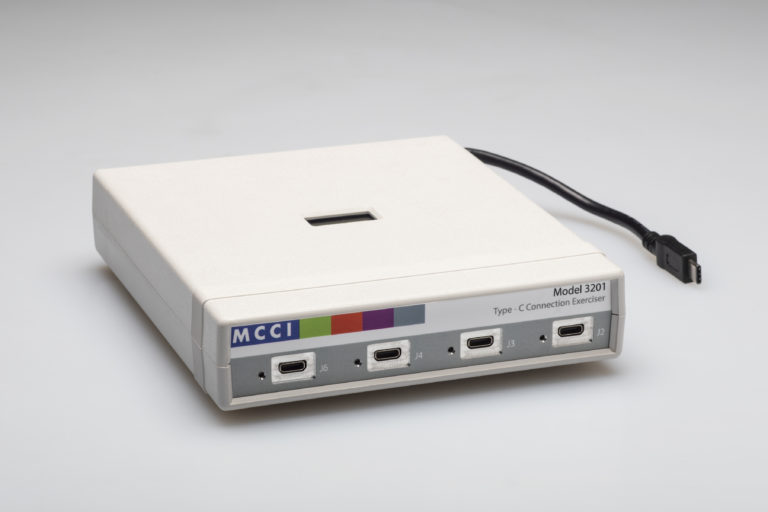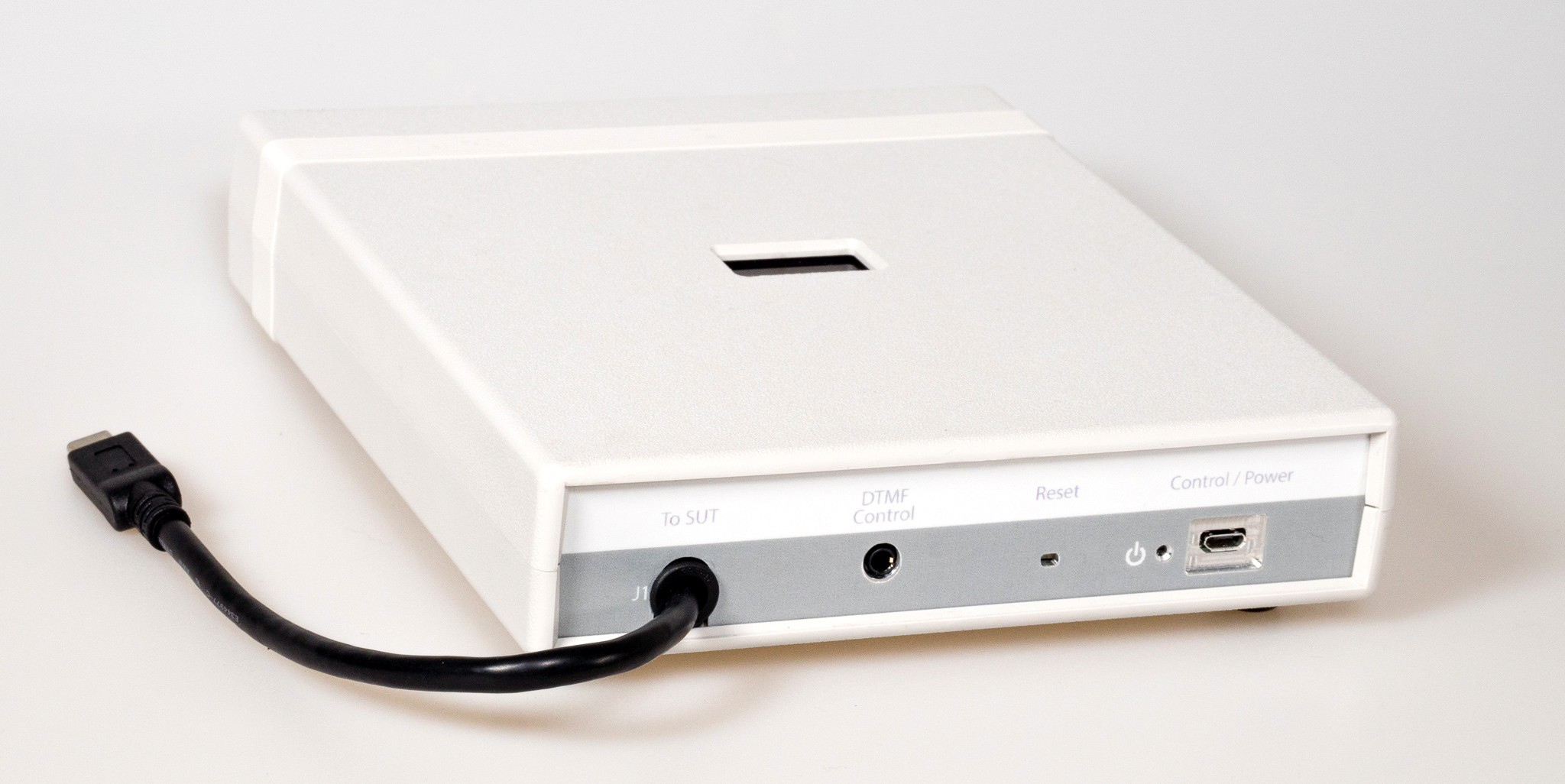Model 3201 Enhanced Type-C Connection Exerciser
Product
Like the Model 3101, the Model 3201 provides a four-to-one USB switch to automate interoperability tests for systems using the Type-C connector. It uses the supplied Arduino and electronic switches to electrically plug and unplug any of the four different input ports. The Type-C plug can be connected to either any of the four Type-C receptacles on the front panel. Two of the Type-C receptacles support USB 3.2 gen 2; the other two support high-speed operation only.
The Model 3201 was developed in conjunction with Microsoft. The design incorporates an Atmga 2560 CPU with Arduino BSP, a USB-serial converter, and control firmware. It works directly with the Microsoft MUTT Software Package. Microsoft provides a complete software stack for testing with the MUTT ConnEX-C using the Windows Operating System. The Model 3201 can also be used directly with customer-written test programs, by sending commands to a virtual serial port provided by the USB control connection, or by sending DTMF commands through a compatible audio port on the control computer.
The 3201 can test hardware that belongs to one of the following categories:
System: Desktops, laptops, tablets, servers, or phones running a SKU of a version of the Windows Operating System with an exposed USB Type-C port.
Dock: Any USB Type-C device that exposes more than one port.
Device: Any USB device with a USB Type-C port that can be attached to a system or dock. This category includes traditional USB devices as well as devices that support the accessory and alternate modes as defined in the USB Type-C Specification.
The 3201 connects to the System Under Test (SUT) via a special captive USB cable. Test devices are attached via the four USB receptacles (labeled J2, J3, J4, J6); when selected, these act as peripherals to the SUT. The embedded firmware monitors amperage and voltage being drawn from the SUT, and displays relevant information on the LCD display.
Device switching is controlled via the USB control port on the rear panel or via Dual-Tone Multi-Frequency (DTMF) signaling through an audio cable. The 3201 can be controlled via an audio signal connected to a standard 3.5mm jack for running the different tests. The test controller proxy can be a desktop PC or a laptop, or the SUT itself (using an analog cable connected to the headset jack of the SUT).
When testing is controlled via USB, power for the 3201 comes from the upstream port. When testing is controlled via audio, the 3201 is normally powered via an external supply.
Features
- Everything you need to start testing immediately. Shipped as a fully assembled and tested unit, with main box, audio cable, USB control cable, preinstalled firmware, and an international power supply.
- Automated USB Type-C interoperability testing.
- Transparent connection between SUT and DUT when in the connected state.
- Impedance controlled, low loss USB data path.
- Uses Pericom PI3DBS12412A in a 12Gbps, 8 to 4 differential channel multiplexer/demultiplexer switch for SuperSpeed signals.
- Uses Fairchild FSUSB74. 4:1 High-Speed USB Multiplexer/Switch for USB2.0, CC, and SB signals.
- Uses TI INA226 to measure voltage and current.
- 10 milliohm, 0.5%, series current sense resistor.
- Handles up to 20V and 5A on VBUS.
- Uses IXYS CPC1907B SSR to switch VBUS on Type-C connectors.
- Uses COTO C226S SSR to switch VBUS on USB 2.0 connectors.
Restrictions
In order to keep the 3201 cost-effective for a variety of applications, a few features were specifically omitted. Contact MCCI if you need more information.
- The 3201 is not designed to handle VCONN powered devices.
- The 3201 does not support automatic Type-C cable flipping.
- The 3201 has been designed for USB 3.2 Gen 2 speeds. It does not support ThunderBolt 3.
Software requirements
Suitable software must be installed on each of the SUT, the test controller proxy, and the 3201’s Arduino-compatible microprocessor.
When using the Microsoft-supplied test software, the requirements are as follows:
- The SUT must be running the version of Windows for which interoperability testing is desired.
- The test proxy controller must be running Windows 10.
- The latest Microsoft MUTT ConnEx-C software package must be downloaded and installed on the proxy controller. It may be obtained from Microsoft via the “Tools in the MUTT Software Package” page.
- The firmware in the Model 3201 must be updated to the version included in the Microsoft distribution.
The Microsoft software package includes utilities to update the firmware, switch between the peripheral ports, and send requests to simulate test cases. It also contains test driver packages that test the functionality of the buses, its controller, and devices connected to the bus.
The firmware for Model 3201 is open source and published on GitHub. Access it here.
MCCI also supports other test scenarios using a USB test control computer, with software available from MCCI, or with customer-written software. Customers can obtain that software directly from MCCI after registering their device.
The Arduino board-support package for the Model 3201 is available online. In the Arduino IDE, add https://github.com/mcci-catena/arduino-boards/raw/master/BoardManagerFiles/package_mcci_index.json to “Additional Boards Manager URLs” under “File>Preferences”, then go to Tools>Board>Boards Manager..., and select the “MCCI-3201-Connection-Exerciser”.
Check out the MCCI Cricket UI, an interactive cross-platform GUI for performing USB connection testing with the Model 3201 Enhance Type-C Connection Exerciser.
Custom Variants
Special variants of the 3201 are available by request. Please write sales@mcci.com with your requirements.
The 3201 vs the 2101
MCCI also offers the Model 2101 USB 3.0 (3.2 gen 1) Connection Exerciser. The 2101 is designed with traditional USB Standard-A and Standard-B connectors, and uses mechanical relays to connect and disconnect the device under test from the system under test. The advantage of this compared to electronic multiplexing is that relays give a more accurate simulation of the physical disconnection. The disadvantage is that the relays required for the very high frequencies of USB 3.2 gen 1 are quite costly; so a multi-port configuration like the 3201 would be much more expensive.
The 3201 allows direct testing of USB Type-C products, including many alternate modes. The 2101 also allows testing of USB modes of USB Type-C products, but requires the use of USB Type-C to Standard-A and/or USB Type-C to Standard-B adapters (not included with the 2101). The 2101 cannot be used in conjunction with most alternate modes.
The 2101 has pushbuttons and uses HID class for remote control. The 3201 lacks pushbuttons, and uses ACM (virtual serial port) for control. Drivers have to be installed when using the 3201 with versions of Windows prior to Windows 10; no drivers are required for the 3201.
The 3201 vs the 3101/3102
The Model 3201 is upwards compatible to the Model 3101. Like the 3102, the 3201 adds the DTMF control capability, but retains the ability to be controlled via USB. The Model 3201 ships with an external power supply and an audio patch cable; the Model 3101 ships only with a USB cable for control purposes.
The Model 3201 connects to the SUT via a special captive USB cable. The Model 3101 and 3102 plug directly into the SUT via an integrated Type-C plug. The 3201 is much more mechanically stable than the 3101/3102, but use of the cable means that ThunderBolt 3 doesn’t work with the 3201, whereas it works with the 3101. (Note, however, that ThunderBolt 3 is not supported by MCCI.)
The 3201 also differs in that it’s a smaller packaged unit that is more like traditional test equipment; whereas the 3101 is larger and ships without an enclosure. The 3201 is thus more suitable for travel or use by individual software developers; the 3101 is more suitable for regression test environments and engineering labs.

